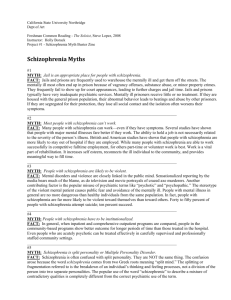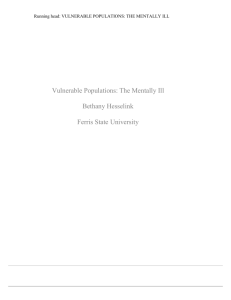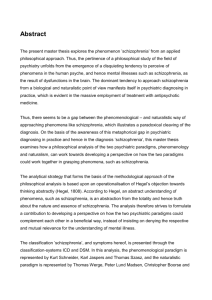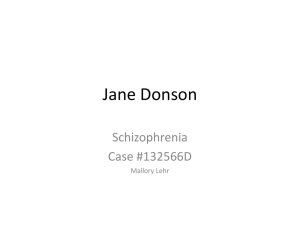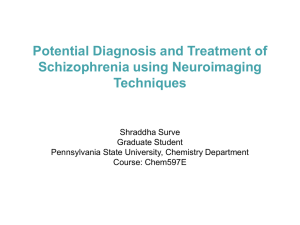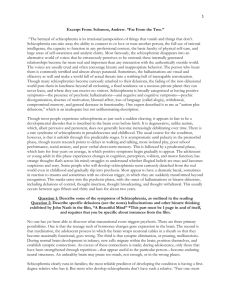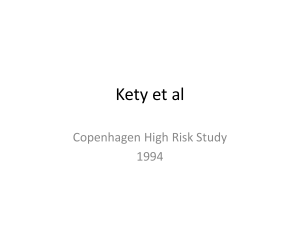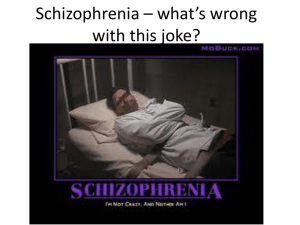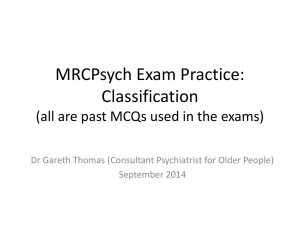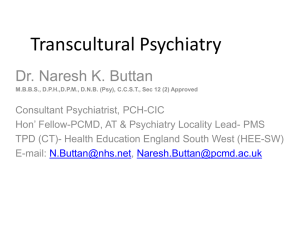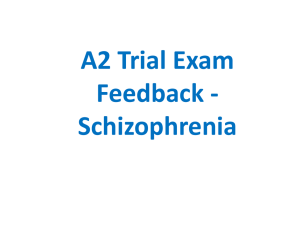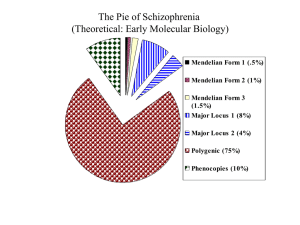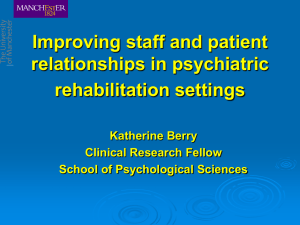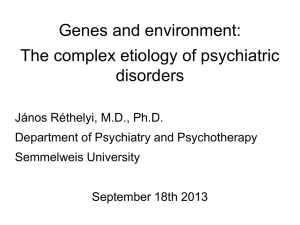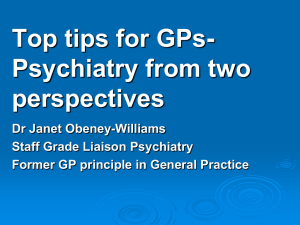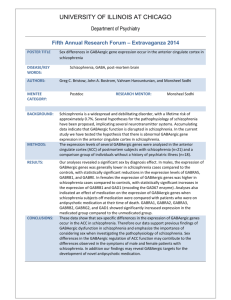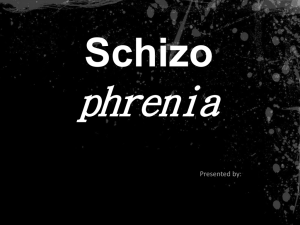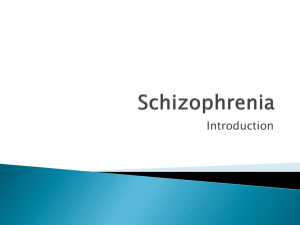PowerPoint
advertisement
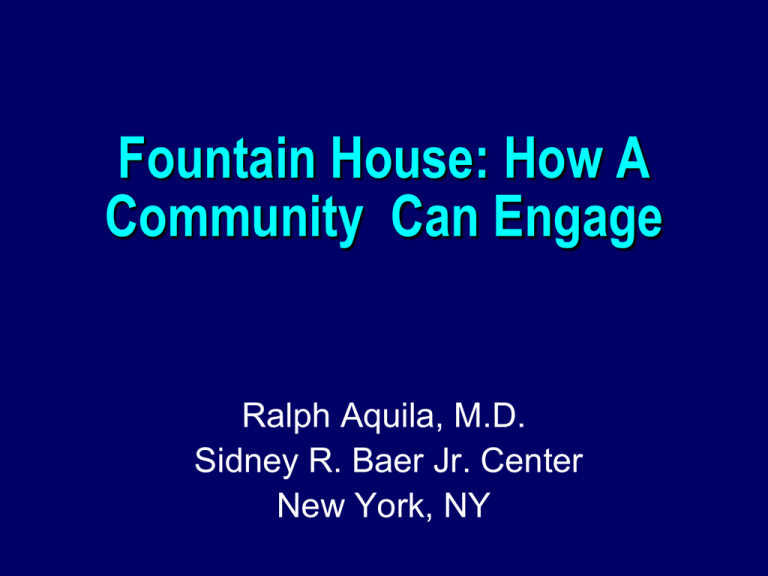
Fountain House: How A Community Can Engage Ralph Aquila, M.D. Sidney R. Baer Jr. Center New York, NY Schizophrenia: “The worst disease afflicting humanity” Strikes 1% of world population or 50 million people Most chronic, debilitating mental illness Person becomes ill in late teens, early 20's - missed opportunities Social toll includes emotional and financial costs to families Persons suffer severe range of symptoms The Burden of Schizophrenia on Individuals All of us need to “fit in” with jobs, friends, family and social activities The isolation, personal devastation and human suffering is enormous Stigma High rate of attempted / completed suicide The Burden of Schizophrenia on Families and Society $32 Billion Direct medical costs: costs of providing care Indirect costs: lost productivity on the part of patients and families Other Costs: social welfare administration, crime and the criminal justice system, homelessness, premature mortality due to suicide Schizophrenia: The Financial Burden 2.5% of U.S. health care costs 22% of mental illness costs 1 in 3 psychiatric hospital beds 25% of admissions to US hospitals 40% of all long term care facilities Source: Rice and Miller 1996 Schizophrenia: Societal and Family Burden Families provide most support caring for loved ones impoverishes families 33% of homeless (Carpenter & Buchanan 1994) Tax payers pay 2/3 of direct costs for schizophrenia (Rice and Miller 1996) Homelessness and Mental Illness At any given time, 200,000 of 600,000 homeless in US are mentally ill 1 There are remedies for homelessness in mentally ill populations 2 –74% to 93% one-year retention rates in supportive housing programs Disproportionate Imprisonment of Mentally Ill Persons in US 3 to 20% of persons in jails are mentally ill (Teplin 1990) “...community correctional institutions, the jail and the police lock-up have become the nations new asylums” (Rock & Landsberg G 1998) “Dubious award” for the largest “mental institution”: Rikers Island, NY vs. LA County jail 9 Suicide Among Mentally Ill Inmates Suicide by inmates with schizophrenia or manic-depressive illness is relatively common. Data collected from New York State jails between 1977 and 1982 showed that half of all inmates who committed suicide had been previously hospitalized for treatment of a serious brain disorder. For each successful suicide in jails, there are many others that are unsuccessful. According to a chief psychiatrist in the Los Angeles County Jail, the ratio of failed suicide attempts to deaths by people with untreated brain disorders is about 20 to 1. Davida Adedjouma 2007 Schizophrenia is treatable Outpatient treatment and rehabilitation programs for people with schizophrenia can reduce psychiatric re-hospitalization rates, improve quality of life, prevent homelessness and increase the likelihood of gainful employment (Hargreaves & Shumway, 1989) Half of the people who receive treatment for schizophrenia either recover completely or are able to live independently with only modest psychosocial support (Biology of Mental Disorders, OTA, 1992) Progressive Stages of Illness in Untreated Schizophrenia Optimizing Outcomes: The Process of Recovery1 Practice Guidelines? Acute Psychosis Long Term What are the outcomes? Clubhouse Intentional community/relationships Membership Made to feel needed Member needs to give back Cost-effective Generalist model > 200 in USA Clubhouse Continued 350 members per day Open 365 days per year 1200 Active members Work Ordered Day Evening and Weekend Program Rehabilitation/Recovery Alliance Collaboration with patient & system, patient (person) becomes co-team leader Treat symptoms with specific goals in mind Focus on strengths & opportunities instead of only psychotic symptoms Aquila et al. Psychiatric Rehabilitation Journal Vol. 23, Num. 1 Relapse: Psychosocial Lack of support • Family &/or caregiver • Stressful environment Complex mental health system • Only 50% of patients keep first outpatient appointment The When of Rehabilitation Geel 1300’s? “Maintenance” before 1980 Psychiatrists not included 1990 ACT model incorporates employment Consumers speak up Clubhouse & psychiatry Other models, The Village, Living Skills Modules … Rehabilitation: a Treatment Necessity Persons with serious mental illness can improve their lives Every person has strenghts Time is an ally Employment and Education as a catalyst Empowerment A Few More Words about Rehabilitation Non-traditional Families settings as Advocates “Workers” as Advocates Patients/consumers advocates as Adherence Tips for Psychoeducation Sessions Ongoing contact with involved families is essential Do not use “confidentiality” as an excuse to avoid making contact with the family Listen carefully for concerns about any side effects Adherence Tips for Psychoeducation Sessions (cont) Family should avoid confrontation over medications Find out if anyone is opposed to medication and try to get that person on board Families can be part of the solution, not the problem Per Diem Cost of NY/NY Housing & Alternatives Per Diem Cost of NY/NY Housing & Alternatives $1,000 $800 $600 $400 $200 $0 Psychiatric Acute Care Hospitals State Psychiatric Hospitals Community Residence Municipal Shelters NY/NY Supportive Housing The Campaign for New York, NY II: Background Report, February 1998. Schizophrenia PORT: Recommendations & Implementation Recommendation • Families should be offered a psychosocial intervention that includes education, support problem-solving & crisis intervention Implementation • Of sample of 540 outpatients with families, 62.8% had not received ANY family contact or treatment in the last 6 months Dixon et al. Schizophrenia PORT. Schizophrenia Bulletin, 1998;24:1.
